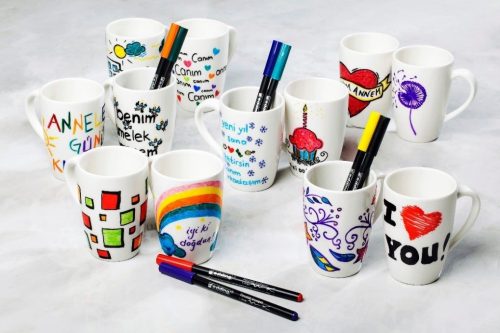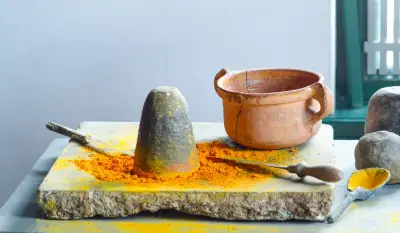Table of Contents
What do you need for your workshop
Before you get started in the world of ceramics, you need to get all the tools and think about a suitable room or workshop.
We generally recommend choosing a large, quiet room. The work area should be well lit and ventilated as lighting is a fundamental part of an artistic process. Large windows, for example, flood a room with plenty of natural light.
However, if you do not have a room with windows, you can also create a good atmosphere with appropriate lamps. It is simply important to always have enough light so that you can work unhindered.
Rooms such as basements, TV rooms, garages, and utility rooms are suitable for working. If you don’t have access to such rooms, you can also set up a pottery studio outdoors with an appropriate roof that shelters against the weather.
When choosing and furnishing a room, you should definitely make sure that it is practically suitable for working and that you feel comfortable in it.
Furniture for your pottery workshop
To set up a pottery workshop, you need a minimum of appropriate furniture.
Shelves or Racks
Shelves are a great ally for any potter. They are not only useful for keeping all tools tidy, but also for drying work before and after firing in the kiln.
Sufficient storage space is always a great advantage in a workshop, especially if you want to keep things tidy.
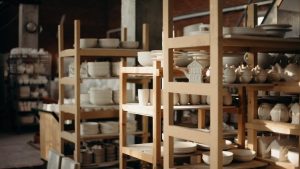
Working and kneading tables
Worktables should be large, stable and at the right height for you. We recommend tables with a wooden, metal, or concrete surface. Tables made of these materials prevent objects from sticking and make cleaning easier.
Chairs
Work ergonomics is an ongoing topic today. Some people like to work standing up, others prefer to work sitting down. It is important to set up the workplace in such a way that you can work relaxed for longer periods of time. Working or sitting surfaces that are too high or too low can have a major impact on productivity and health.
Choosing the right chair is not complicated. Here are three tips to help you choose the right chair for your workshop.
- The chair should be the right height for you in relation to the work surface. Height-adjustable chairs are often a good option.
- A chair should be made of solid materials and offer stability. Remember, buying twice is more expensive than buying once.
- We recommend a chair with a backrest. This means that more seating positions are possible and you can simply relax in between.
Of course, you can create different seating options for different work areas and activities if there is enough space.
Water and washing point
This is one of the most important points when setting up a ceramic workshop at home.
In our workspace we need water and washing spot that we use to wash items like brushes and to quickly clean dirty items.
Essential tools for your pottery workshop
Below are all the tools that a potter needs in his pottery workshop.
Aprons and towels
The world of art is also the world of colors and materials, so you will definitely get a little dirty. Aprons are excellent for protecting our normal clothes.
There are different types of aprons in all colors and patterns, suitable for every taste and body. But don’t forget that your apron should be long enough to give you enough protection. One or two pockets in the apron are also always handy.
We, therefore, recommend wearing loose and comfortable clothing under an apron, since it cannot cover the whole body.
Towels are another important tool. These will help you keep everything clean. We recommend at least two towels, one for your hands and one for the rest, preferably made of cotton. This material is resistant and absorbs all types of liquids very well.
Mask
These utensils may seem unimportant, but they actually aren’t.
Masks are indispensable when working with all ceramic materials. It prevents the inhalation of dust or odors through the nose and mouth.
We recommend polyester masks. This material is lightweight, washable, and does not deform or wrinkle. In addition, they hardly absorb any moisture, which is an advantage with regard to bad smells, fungi, and bacteria.
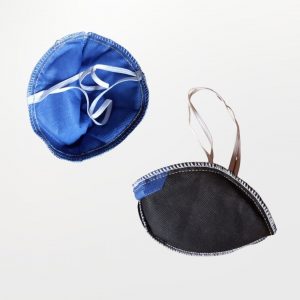
We also recommend industrial masks, which are commonly used by construction workers and carpenters. These are readily available and affordable.
Wearing masks is not compulsory but good to protect very well. We recommend its use primarily by people with allergies or people who suffer from respiratory diseases.
Loam and clay
Clay is a natural material and loam consists of clay, sand, and silt (floating sand). What material should I use for pottery? A very common question that every beginner has asked himself at some point.
In pottery, we use clay to make the different pieces. There are different types of clay, and their uses are different.
Porcelain
Porcelain is a very fine, so white ceramic clay that can even become transparent. It is also the most expensive material among the three types of ceramics.
Porcelain requires firing temperatures of between 1,240 and 1,350º C. So if one chooses porcelain, one must have a high temperature kiln.
Stoneware
This type of ceramic is characterized by its different colors. There is white, grey, red and even orange. Stoneware is fired at average temperatures of 1,200 to 1,280ºC.
Stoneware clay is commonly used for making tableware and pottery such as bottles and vases, both of which are made from clay.
Earthenware
Earthenware is the most porous of all clays and is used to make tableware, making it the easiest to work with.
The temperature required for earthenware is the lowest of the three materials, so you don’t need a high-power kiln.
Sponges
Sponges are essential for soaking up and measuring water.
There will be situations where you need a certain amount of water to make your mixes and other crafts; Sponges prevent you from using more water than you need.
Bucket
One or more buckets help in every workshop. These can be used for water, leftover paint or leftover clay.
Paintbrush
Brushes are one of the most essential tools to give objects a personal touch.
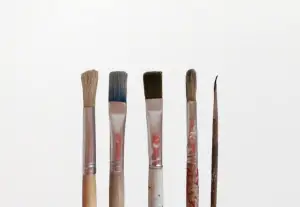
There are special brushes for ceramics and models with thin and wide tips. However, before you buy a huge set of specialty brushes, you should start with a few standard brushes first.
We recommend using 4 to 5 brushes of different sizes.
Tools for lathing
These tools are essential for shaping your ceramic figures. With the right tools, turning will be a breeze.
Create your own lathing tool set. These include spatulas, gravers or needles, sandpaper, a gouging tool, a modeling stick, wooden forming tools, a rolling pin, profiles, wooden scrapers, and lathes.
These pottery tools make the whole turning process easier by helping you shape, remove, cut and add clay to your ceramic figurine.
Glazes and acrylic paints
Glazes and acrylic paints are the right colors for ceramics. Acrylic paints are used to add color to the pieces you make. Glazes are used to seal them and give them a glossy or matte finish.
Various acrylic paints and glazes are available on the market. To glaze a piece, we advise you to buy ready-made powder from a dealer of artistic pottery tools.
Extra tip: once you’ve glazed your figurine, be sure to place it in the kiln at the right temperature, depending on the clay you used.
Potter’s wheel
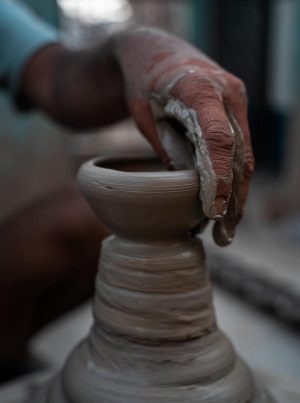
A potter’s wheel is a device that rotates and works the mass on its surface. There are different types of lathes, ranging from electronic to manual lathes that are operated with the potter’s leg.
It won’t be easy to use the lathe at first, but with a little practice, you’ll get there quickly.
Ceramic kiln
Choosing a kiln is not an easy task as there are countless types of ceramic kilns available today. There are e.g. B. electric furnaces or gas furnaces. In addition, there are various brands of gas and electric ovens, such as SHIOUCY, Akozon, and YGLONG.
Consult a professional to find the one that’s right for you.
This is an overview of the basic equipment in a workshop and we hope you enjoy setting it up.

